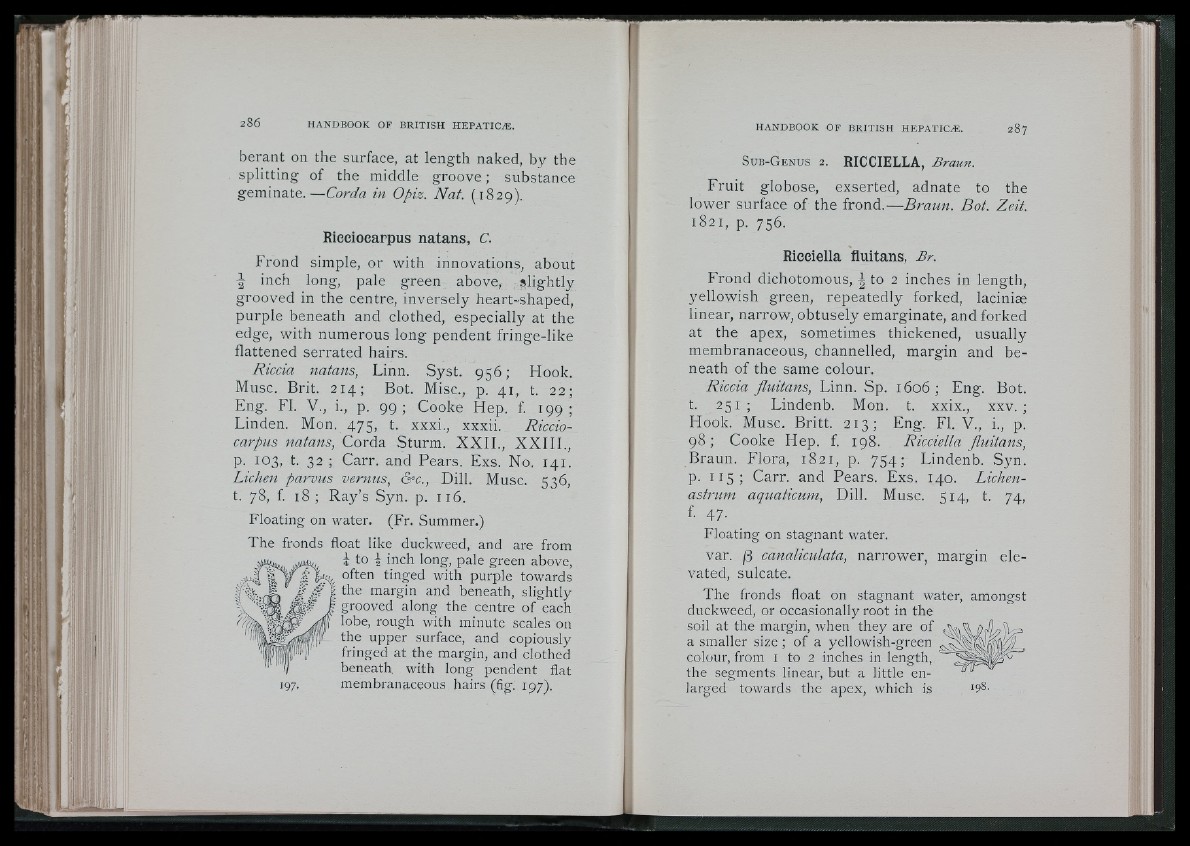
'ÎE berant on the surface, at length naked, by the
split t ing of the middle g ro o v e ; substance
g emma te .— Corda in Opiz. Nat. (1829).
Riceioearpus natans, C.
Frond simple, or with innovations, about
inch long, pale green above, s l ight ly
g ro o v ed in the centre, inve r s e ly heart-shaped,
purple beneath and clothed, especially at the
edge, with numerous long pendent fringe- l ike
flattened serrated hairs.
Riccia natans, Linn. S y s t . 9 5 6 ; Hook.
Muse. Brit. 2 1 4 ; Bot. Misc., p. 41, t. 22;
Eng. FI. V., i., p. 9 9 ; Co o k e Hep. f. 1 9 9 ;
Linden. Mon. 475, t. xxxi., xxxii. Riccio-
carpiis natans, Corda Sturm. X X I I . , X X I I I . ,
p. 103, t. 32 ; Carr, and Pears. Exs. No. 141.
Lichen parvus vernus, & c .. Dill. Muse. 536,
t. 78, f. 18 ; R a y ’s S yn. p. 1 16.
Floating on water. (Fr. Summer.)
The fronds float like duckweed, and are from
Mt,. i inch long, pale green above,
, often tinged with purple towards
Jf J- the margin and beneath, slightly
" I grooved along the centre o f each
f lobe, rough with minute scales on
/ the upper .surface, and copiously
fringed at the margin, and clothed
beneath, with long pendent flat
197, membranaceous hairs (fig. 197).
Sub-Genus 2. RICCIELLA, Braun.
Fruit globose, exserted, adnate to the
lowe r surface of the frond.— Braun. Bot. Zeit.
1821, p. 756.
Rieeiella fluitans, Br.
Frond dichotomous, to 2 inches in length,
y e l lowish green, repeatedly forked, laciniæ
linear, narrow, obtu se ly emarginate, and forked
at the apex, somet imes thickened, usually
membranaceous, channelled, margin and beneath
o f the same colour.
Riccia fluitans, Linn. Sp. 1606 ; Eng. Bot.
t. 251 ; Lindenb. Mon. t. xxix., xxv. ;
Hook. Muse. Britt. 2 1 3 ; Eng. FI. V., i., p.
98 ; Co o ke Hep. f. 198. Riccietta fluitans,
Braun. Flora, 1821, p. 7 5 4 ; Lindenb. S yn .
p. 1 1 5 ; Carr, and Pears. Exs . 140. Lichenastrum
aquaticum. Dill. Muse. 514, t. 74,
f. 47.
Floating on stagnant water.
var. j3 canaliculata, narrower, margin elevated,
sulcate.
The fronds float on stagnant water, amongst
duckweed, or occasionally root in the
soil at the margin, when they are of
a smaller size ; of a yellowish-green
colour, from i to 2 inches in length,
the segments linear, but a little enlarged
towards the apex, which is
i